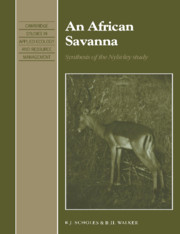Book contents
- Frontmatter
- Contents
- Preface
- I Nylsvley in an African savanna context
- 1 African savannas: an overview
- 2 The people of Nylsvley
- 3 The climate at Nylsvley
- 4 Geology, landform and soils
- 5 The Nylsvley biota
- II The key determinants: water, nutrients, fire and herbivory
- III The carbon cycle
- IV Community and landscape pattern and change
- Part V Lessons from Nylsvley
- Bibliography
- Index
3 - The climate at Nylsvley
Published online by Cambridge University Press: 06 October 2009
- Frontmatter
- Contents
- Preface
- I Nylsvley in an African savanna context
- 1 African savannas: an overview
- 2 The people of Nylsvley
- 3 The climate at Nylsvley
- 4 Geology, landform and soils
- 5 The Nylsvley biota
- II The key determinants: water, nutrients, fire and herbivory
- III The carbon cycle
- IV Community and landscape pattern and change
- Part V Lessons from Nylsvley
- Bibliography
- Index
Summary
Climate is the ultimate determinant of savanna distribution. The prolonged hot dry season permits the frequent, hot fires which are essential for maintaining the tree–grass mixture.
Nylsvley has a typical savanna climate: a hot wet season and a warm dry season. A brief review of the climatic processes which influence the weather at Nylsvley illustrates some features which are common to savannas in general. The details differ between the northern and southern African savannas because of the greater width of the continent in the north. The influence of the oceans in the southern subcontinent causes the rainfall isohyets there to lie in a north–south direction, rather than the east–west orientation typical of the Sahelian Region. The East African savannas span the equator and therefore have a monsoonal climate, with two wet and two dry seasons per year.
In global terms, savannas are located between the equator and about 30° latitude. In relation to the global atmospheric circulation, this is between an area of divergence (subsiding air) known as the subtropical high-pressure ridge, where the Hadley and Ferrel cells meet, and an area of convergence (rising air) where the north and south Hadley cells meet. Descending air is dry and stable, and therefore not conducive to rainfall; the opposite is true of rising air. The latitudinal location of these zones moves north and south in response to the annual cycle of the earth–sun system.
- Type
- Chapter
- Information
- An African SavannaSynthesis of the Nylsvley Study, pp. 24 - 33Publisher: Cambridge University PressPrint publication year: 1993

